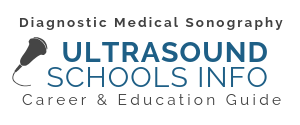Sonographers are highly trained individuals who use specialized equipment that produces sound waves to image the inside of the body. Admittance to ultrasound school is competitive, and the educational and training process is rigorous.
Mastering the terminology is one important element of a sonographer’s education. The ultrasound tech must have a firm understanding and quick recall of the terms and acronyms that are used every day in the workplace.
Below you will find definitions for the most common terms and acronums used in medical sonography.
Terms in Diagnostic Medical Imaging
A-C
ARDMS – American Registry for Diagnostic Medical Sonography
Accreditation – The act of establishing educational standards, and assessing and monitoring whether an institution meets those standards. Typically administered by non-profit governing bodies.
Applications Specialist – A sonographer who specializes in training and education on applications specific to a product or device.
CAAHEP – Commission on Accreditation of Allied Health Education Programs
CCI – Cardiovascular Credentialing International
Cardiovascular Sonography – A specialization within the medical field that diagnoses and treats problems associated with the heart and blood vessels.
Central Processing Unit (CPU) – The computer that does the calculations that turn the returned sound waves into images.
Clinical – Coursework designed to give students practical experience in a field setting (such as a hospital or outpatient clinic) of didactic knowledge and laboratory skills learned in formal education settings.
Continuing Medical Education (CME) – Activities related to the continuance of a sonographer’s knowledge and skills often required by certifying bodies as well as employers.
Credential – A specialty-specific designation awarded to a sonographer that has successfully demonstrated prerequisite didactic knowledge and practical skills in the specialty area.
D-I
Ergonomics – The study between an employee and their work environment. For example—maintaining optimal ergonomics utilizing an ultrasound machine to prevent musculoskeletal strain or injury.
Impressions/Preliminary Report – A report of technical findings from the sonographer performing the exam that is reviewed and utilized by the interpreting physician.
Internship/Externship – An extension of didactic and laboratory education that can be part of clinical experiences or entry-level work experiences in which a student may continue to hone techniques and skills of a sonographer under supervision.
Invasive ultrasounds – Most ultrasounds are done on the outside of the body. However, occasionally an invasive ultrasound is needed, which means that the transducer is inserted inside the body, such as in a transvaginal or transrectal ultrasound. There are no incisions involved, rather the probe is placed into a natural opening on the body.
J-L
JCAHO – Joint Commission on the Accreditation of Healthcare Organizations, often referred to as The Joint Commission.
JRD/DMS – Joint Review Committee on Education in Diagnostic Medical Sonography.
Laboratory Setting – Educational setting in which sonography students can learn, practice, and be assessed on sonographic techniques and examinations.
Lead Sonographer – Supervisor of sonography staff.
License – Designation of ability to perform certain skills and practices as outlined by appropriate education and practice. Example—some states require sonographers to be licensed to perform sonographic examinations in addition to being registered through an appropriate credentialing body.
M-R
Non-invasive – Refers to the nature of an examination that generally does not involve breaking the skin or entering the body of a patient.
PACS – Picture Archive and Communication System.
Professional Society – An organization of individuals in the same work area that serves to advance and advocate for the profession.
Radiologic Technologist – A healthcare professional that specializes in diagnostic imaging, often in the specialties of x-ray, computed tomography, magnetic resonance imaging, and other specialty areas.
Radiologist – A physician specializing in interpreting diagnostic imaging studies.
S-Z
SDMS – Society of Diagnostic Medical Sonography.
Shift Differential – Additional compensation outside of routinely scheduled hours.
Simulations – Experiences in a controlled, simulated environment to practice skills and routines for various patient care scenarios.
SPI – Sonographic Physics and Instrumentation.
Transducer – A transducer is a device that converts energy from one type to another. In sonography, the transducer sends high frequency sound waves and then receives them back.
Transducer Pulse Controls – Used by the ultrasound tech to change the amplitude, frequency, and duration of the sound waves emitted from the transducer.
Ultrasound – Sound waves beyond the range of the human hearing above twenty kilohertz.
Other pages you might like:
- Who’s Who in Sonography – Explore the various organizations within ultrasound
- History of Ultrasound – Trace ultrasound back to its beginnings in 1794
- Ultrasound Technology – Learn how ultrasounds work
